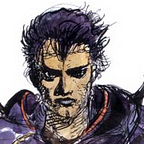Most long-running game series have a “black sheep” or two. While I don’t consider myself a contrarian, for the kind of oft-ignored entries that get this label, I’m inclined to go against the grain and at least try to see the best in them. Yeah, I can admit my biases — that’s one of ’em. Well, Fire Emblem Gaiden (a.k.a., Fire Emblem 2) is about as ignored as games from otherwise popular series get, in part because it never saw a Western release; however, thanks to modern technology and the benevolent dedication put into fan translations, I booted up this Famicom classic on a whim, fully expecting to uncover a gem in the quagmire, one so many haters have overlooked.
Yet despite my best intentions, I’ve got to side with the majority of fans on this one: Fire Emblem Gaiden’s a stinker … as far as FE games go. It’s still Fire Emblem, meaning it’s still got that core modicum of fun, which I’ll get to, but first: far and away the biggest problem constantly smacking you in the face is Gaiden’s hit rates. Nearly every weapon has piss poor accuracy by FE standards, even compared to the first game. I’ve read that Gaiden uses a “true accuracy”, or one-roll check, where the stated weapon accuracy is the actual chance, instead of the 2-roll system most of the other games use. I won’t go into the details here, but basically, in most FE games, if the stated accuracy is above 50%, the real accuracy is actually higher than what’s stated, producing results closer to players’ irrationally human expectations. (Vice versa if it’s lower than 50, but no player would use such a bad weapon.)
That’s not the case here, and it’s instantly noticeable. You do get better weapons eventually, but only one at a time, and on large maps with large squads, you hardly notice the improvement. Not being able to hit the broad side of a barn would consistently kill any excitement or momentum the game manages to gather. Battles in Gaiden feel like a chore. Sprawling maps with multiple large groups of enemies crop up often, and with five chapters, each featuring tons of mandatory battles, it all feels like too much given the heavy reliance on RNG. It’s no help that Gaiden retains the general slowness of gameplay from the first game. After around halfway through, as maps got more and more dense, I stopped having fun.
Compare that to the Shining series, where each new map felt exciting, like a fun challenge I couldn’t to strategize my way through. Sure, those games fall on the easy side, but FE’s difficulty comes mainly from its boorish RNG. I don’t want 100% accurate weapons or anything, but Gaiden goes too far in the other direction. I got into it enough to keep going, thanks to emulator speedup and occasional save scumming, but if I didn’t have that? I dunno. The grind might have been more than I could handle — I might have even dropped it, a rarity for me and JRPGs.
Thankfully, Fire Emblem Gaiden’s got a few qualities worth praising, such as its total revamp of FE1’s awful inventory system. Since you now navigate an overworld map now, units can swap items at any time between battles — Hallelujah. There’s towns with shops, shrines where you promote units, and a general sense of immersion the first game lacked. Alm and Celica, the dual protagonists, get plenty of dialogue, portraits, and cutscenes that bring them to life during their campaigns across Valentia in a way Marth never saw in the first game (sorry, Marth). FE1 felt like reading a story book; Gaiden feels like playing a Fire Emblem game.
To accompany the meatier world, the story’s a lot more interesting and involved, too. Instead of a few quick text boxes after each battle, longer dialogue and character moments play it, along with optional scenes to find, characters to recruit, and promotions to reach. Discovering Alm and Celica’s roles in what turns out to be the endgame of a historic clash between humans and gods is pretty heavy stuff for a NES game and falls more in line with what I’d expect from a modern Fire Emblem game. I mentioned this in my retrospective on FE1, and it again applies here: I’m astounded by how many elements of modern Fire Emblem Intelligent Systems had figured out all the way back in the early 90s. You’ve got two separate armies that fight their own battles with only occasional overlap, nonlinear exploration of a world, and an epic campaign with multiple rug-pulls and new “big bads” emerging.
That’s not to mention game length. Hoo boy, this is a long one. I thought FE1 was chunky, but looking back, it only had twenty-six chapters, most of which take less time than your average story battle in Gaiden. FE2’s got about fifty, plus forced additional encounters when you get trapped by enemies on the overworld. That’s way more than I wanted to go through, given my complaints with the game. If I having a great time, then sure, give me fifty battles — give me a hundred battles, no problem. I played through Three Houses four times, for God’s sake. But FE2 got too lofty in its ambitions while ignoring the basics of what makes a fun game.
When I get all the way through a retrospective and don’t mention the music, that’s how you know the game depresses me. Yuka Tsujiyoko delivers another fine soundtrack, absolutely solid, in fact, but nothing stands out in particular — certainly nothing like that damn catchy Kingdom Seized ditty from FE1. It’s more Fire Emblem and fits well. I only wish the game were more fun.
As always, thanks for reading, and stay tuned for December’s JRPG, Wild Arms, coming soon!
